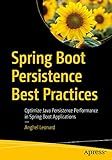Best Hibernate Optimization Tools to Buy in December 2025
To optimize Hibernate performance, several strategies can be implemented. One approach is to carefully design database schema, ensuring that the required indexes are in place to facilitate efficient query execution. Another strategy is to use appropriate caching mechanisms, such as second-level cache and query cache, to reduce the number of database calls and improve response times.
Additionally, tuning the Hibernate configuration settings can have a significant impact on performance. This includes settings related to the connection pool, batch processing, and fetching strategies. It is important to experiment with different configurations to find the optimal settings for your specific application.
Furthermore, minimizing the number of database calls by fetching only the necessary data, using lazy loading and batch fetching, can help improve performance. Avoiding unnecessary database interactions can reduce the load on the database server and improve overall performance.
Lastly, profiling and monitoring the application using tools like Hibernate Profiler or JProfiler can help identify performance bottlenecks and areas for improvement. Regularly monitoring and tuning the application can ensure that it continues to perform optimally as the data and user load increases.
What is the role of caching in Hibernate performance optimization?
Caching in Hibernate plays a crucial role in improving performance by reducing the number of database queries and network round-trips.
- First-level cache: Hibernate has a first-level cache that is enabled by default. It stores objects that have been read from the database during a session. When an object is requested multiple times within the same session, Hibernate can retrieve it from the cache instead of querying the database again. This reduces the number of queries and improves performance.
- Second-level cache: Hibernate also supports a second-level cache, which is shared among multiple sessions. This cache can store data that is not specific to a single session, such as reference data or commonly accessed entities. By enabling the second-level cache, Hibernate can retrieve objects from the cache instead of hitting the database, improving performance for frequently accessed data.
- Query cache: Hibernate also provides a query cache, which stores the results of queries and their associated objects. When the same query is executed again, Hibernate can retrieve the results from the query cache instead of executing the query again. This can significantly reduce the amount of time spent executing queries and improve performance.
Overall, caching plays a crucial role in Hibernate performance optimization by reducing the number of database queries and network round-trips, thereby improving the overall performance of the application.
What is the impact of concurrency control on Hibernate performance enhancement?
Concurrency control in Hibernate ensures that multiple users can access and modify the same data in a database system without causing conflicts or inconsistencies. By implementing concurrency control mechanisms, such as locking, Hibernate can improve performance by preventing data corruption and reducing the frequency of conflicts that require rollback.
However, concurrency control mechanisms can also introduce overhead and impact performance in certain scenarios. For example, if a large number of users are trying to access and modify the same data concurrently, the locking mechanisms used by Hibernate may cause delays and decrease throughput, resulting in decreased performance.
Therefore, it is important to carefully consider the specific concurrency control mechanisms implemented in Hibernate and how they will impact the overall performance of the application. It is also recommended to conduct performance testing and optimization to ensure that concurrency control does not negatively impact the application's performance.
How to optimize Hibernate performance by using effective indexing?
- Use unique indexes: Unique indexes can help improve query performance by ensuring that the database does not have to scan the entire table to check for uniqueness. This can be particularly useful for fields that are frequently used in searches or comparisons.
- Clustered indexes: Clustered indexes can help improve performance by physically ordering the rows in the table based on the index key. This can reduce the amount of data that needs to be read from disk when retrieving rows that are located close together in the index.
- Composite indexes: Composite indexes can be used to index multiple columns in a table, which can be useful for queries that involve multiple conditions or join operations.
- Indexing foreign key columns: Indexing foreign key columns can improve performance when querying data across tables with relationships.
- Use lazy loading: By using lazy loading in Hibernate, you can reduce the amount of data retrieved from the database at any one time, which can help improve performance. This can be done by setting the fetch type to lazy for associations in your entities.
- Use batch fetching: By using batch fetching in Hibernate, you can reduce the number of queries executed against the database, which can help improve performance. This can be done by setting the batch size property on your associations.
- Monitor and optimize queries: Use Hibernate tools like the Hibernate statistics API to monitor and analyze query performance. This can help you identify slow-performing queries and optimize them by using indexes, rewriting the query, or adjusting fetch strategies.
By following these tips and best practices, you can optimize Hibernate performance by using effective indexing.




